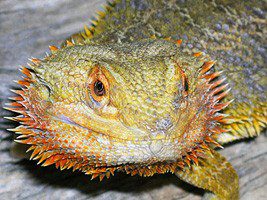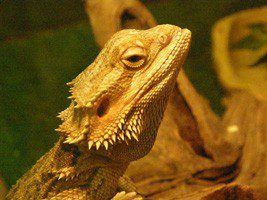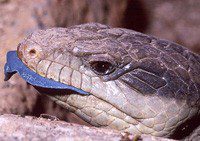
Agama bearded
The bearded agama (Pogona vitticeps) is a lizard that even a novice terrariumist can have. Nature endowed this creature with an amazing appearance and sufficient unpretentiousness for life at home. The bearded dragon is native to the Australian continent. At one time, the Australian authorities very strictly controlled the export of representatives of the local fauna, but still the relatives of the agama fell outside the mainland and began to successfully breed in other territories that were quite suitable for them in terms of habitat conditions. The bearded agama is amazing not only in its appearance, but also in the name directly associated with it. The Latin word Pogona in translation just means the presence of a beard, and vitticeps has an even more bizarre meaning – “bulb headband”. So the Latin name of the lizard indicates the presence of leathery spikes around the ears, on the head and throat of the agama. These spikes just imitate a beard. Because of this sign, the British even called the agama the bearded dragon – the central bearded dragon. And another unique ability of the bearded dragon is to change color when the lizard is frightened or worried. In this state, the bearded agama brightens, and its paws acquire a bright yellow or orange hue. The color of the lizard can also change depending on the ambient temperature.
Contents
Bearded Agama Pogona vitticeps
Kingdom: Animals
Type: Chord
Class: Reptiles
Order: Scaly
Suborder: Lizards
Family: Agamaceae
Genus: Bearded dragons
Appearance
In a different way, the bearded agama is also called running. This is a medium-sized lizard, its body is wide and slightly flattened. And the same head, a bit reminiscent of a triangle. Ahead on the neck of the bearded agama are prickly scales – “beard” – arranged in a wedge. The same processes surround the corners of the mouth and the ear openings. The bearded dragon has rather strong paws of gray, brownish or dark tone with short clawed fingers. The skin around the jaws is visibly lighter. Spiny scales cover the inside of the belly between the front and hind legs. Bearded dragons are characterized by sexual dimorphism. Males are distinguished by a wider head and a thicker tail, especially at its base, around the hemipenis, the reproductive organ of lizards. The beard of males is also more prominent and darker in color, especially during mating season, while that of females is orange or beige. But determining the sex of a bearded agama, especially one that has not yet entered the breeding season, is not an easy task. The standard length of these lizards is 40-60 cm. The length of the tail is approximately 40% of the body size. The agama’s beard becomes especially noticeable when the lizard inflates its throat and strongly pushes the throat fold forward. In this, she is helped by elongated processes of the hyoid bone, which protrude when the bearded dragon opens its mouth. The frilled lizard has a similar ability. On the sides of the body of the agama there are also spiny processes in several rows. When the lizard is worried or preparing to defend itself, it inflates its body, as it were, and these spikes are more widely distributed to the sides. The color of the back of the bearded agama can be green, bluish or with a yellow tint and can also change depending on the mood of the lizard.
Distribution and habitation
 The bearded dragon is a native Australian animal. She lives mainly in the inland rather than coastal regions of the mainland, in particular, in the state of Queensland, New South Wales and north-west Victoria, as well as in the east of South Australia and the south-east of the state with an interesting name – the Northern Territory. The biotopes preferred by the bearded agama are mostly desert and semi-desert – rocky or covered with dry vegetation areas, thickets of shrubs. The lizard lives on the ground and sometimes in trees. It is especially active during the day, and at night and in extreme heat it hides in holes that it digs itself, or in other people’s holes, as well as in stone rubble and under the roots of plants. The bearded agama is also looking for coolness on trees, in places that are well ventilated. Each lizard has its own territory, which it tries to keep. Sometimes a bearded agama can also be found in cities, next to people.
The bearded dragon is a native Australian animal. She lives mainly in the inland rather than coastal regions of the mainland, in particular, in the state of Queensland, New South Wales and north-west Victoria, as well as in the east of South Australia and the south-east of the state with an interesting name – the Northern Territory. The biotopes preferred by the bearded agama are mostly desert and semi-desert – rocky or covered with dry vegetation areas, thickets of shrubs. The lizard lives on the ground and sometimes in trees. It is especially active during the day, and at night and in extreme heat it hides in holes that it digs itself, or in other people’s holes, as well as in stone rubble and under the roots of plants. The bearded agama is also looking for coolness on trees, in places that are well ventilated. Each lizard has its own territory, which it tries to keep. Sometimes a bearded agama can also be found in cities, next to people.
Behavior and lifestyle
 The menacing appearance of the bearded dragon can be confusing. In fact, this creature, if tamed, is very affectionate, easily given in the hands and enjoys scratching the neck. However, during the mating season, males show a frightening outfit – they inflate their necks and protrude their scales, which immediately noticeably darkens. The lizard behaves in the same way when it defends itself. By the way, the bearded dragon is quite fearless. She is in no hurry to run away from the enemy, but tries to scare him. In addition to external changes during aggression, the bearded agama can snort, actively move its tail, hiss and jump, squatting on its paws, which is very reminiscent of a frog. By the color of the beard, it is easy to determine the mood of the lizard – the darker it is, the more worried the agama is. And in terrariums, you can hardly find bearded dragons with a long tail, although this is a natural sign of the animal. When several lizards are kept together, collisions are possible between them, in which the agamas bite off each other’s tails. And although the site of injury soon heals, the tail itself, alas, never grows again. Therefore, experienced terrarium keepers try to keep bearded dragons separately, which is obtained only in well-equipped nurseries.
The menacing appearance of the bearded dragon can be confusing. In fact, this creature, if tamed, is very affectionate, easily given in the hands and enjoys scratching the neck. However, during the mating season, males show a frightening outfit – they inflate their necks and protrude their scales, which immediately noticeably darkens. The lizard behaves in the same way when it defends itself. By the way, the bearded dragon is quite fearless. She is in no hurry to run away from the enemy, but tries to scare him. In addition to external changes during aggression, the bearded agama can snort, actively move its tail, hiss and jump, squatting on its paws, which is very reminiscent of a frog. By the color of the beard, it is easy to determine the mood of the lizard – the darker it is, the more worried the agama is. And in terrariums, you can hardly find bearded dragons with a long tail, although this is a natural sign of the animal. When several lizards are kept together, collisions are possible between them, in which the agamas bite off each other’s tails. And although the site of injury soon heals, the tail itself, alas, never grows again. Therefore, experienced terrarium keepers try to keep bearded dragons separately, which is obtained only in well-equipped nurseries.
Food
The diet of the bearded dragon is mixed. From animal food, these are various small vertebrates and invertebrates, and from plant food – leaves, shoots, fruits and flowers of various plants. In captivity, bearded dragons are happy to eat crickets, cockroaches, mealworms, and other insects. Snails, bird eggs, small rodents can also become a source of animal protein for lizards. And among the succulent foods of the bearded agama, various grated vegetables and fruits are useful – carrots, apples, cabbage, pears, bananas, tomatoes, cucumbers, beans, lettuce and dandelion leaves. Breeders recommend putting this food in special low but wide bowls, and when the lizard is full, take them out of the terrarium. And yet, the main share in the diet of the bearded agama is occupied by animal food. For young lizards, similar feeding is recommended, only in smaller portions. The number of meals for a bearded dragon should be at least once every two days, and it is better to diversify the foods given to her. The drinking bowl must always have clean water. And to maintain the health of the bearded agama, it is recommended to periodically give special mineral supplements, for example, crushed egg shells, calcined powders, etc. By the way, mineral water can be added to ordinary water in a drinking bowl. As for vitamins for the bearded agama, it is better to offer them to the lizard no more than once a month. You can also feed her with special reptile food, but only in accordance with the instructions that come with them.
Reproduction
 Bearded dragons, like other lizards, are egg-laying creatures. They become able to reproduce offspring two years after birth. In nature, bearded dragons make large clutches – 9-24 eggs. They lay them in a hole dug by the female and then bury her entrance. And after about 3 and a half months, small agamas appear. At home, the reproduction of bearded agamas is subject to certain rules. The mating season for lizards begins after the end of wintering. They are prepared for this by feeding them with special preparations with vitamin E. And when the males “dress up” in a bright wedding attire, they are planted with the females. Male bearded dragons also have their own ceremonies for attracting “girls”. They show them the bright color of their neck, rise on their paws and, as it were, nod their heads. And the females respond to them with similar nodding and tail movements. Then comes the time of marital persecution. The male bearded dragon catches the female and, grabbing her with his teeth, proceeds to mate. A month and a half later, the females lay eggs. To do this, girls of bearded dragons are planted in a special terrarium, where they can dig a hole for a nest. The bottom of such a terrarium is abundantly covered with sand, so that the female’s hole can be up to 40 cm deep. But the masonry does not remain in the nest. Then she is transferred to an incubator, where she is kept at a temperature of about +28 degrees, sufficient for the offspring to hatch in a maximum of three months. If the temperature is slightly higher, then small bearded dragons appear earlier. During the season, the bearded agama lays eggs up to 2 times.
Bearded dragons, like other lizards, are egg-laying creatures. They become able to reproduce offspring two years after birth. In nature, bearded dragons make large clutches – 9-24 eggs. They lay them in a hole dug by the female and then bury her entrance. And after about 3 and a half months, small agamas appear. At home, the reproduction of bearded agamas is subject to certain rules. The mating season for lizards begins after the end of wintering. They are prepared for this by feeding them with special preparations with vitamin E. And when the males “dress up” in a bright wedding attire, they are planted with the females. Male bearded dragons also have their own ceremonies for attracting “girls”. They show them the bright color of their neck, rise on their paws and, as it were, nod their heads. And the females respond to them with similar nodding and tail movements. Then comes the time of marital persecution. The male bearded dragon catches the female and, grabbing her with his teeth, proceeds to mate. A month and a half later, the females lay eggs. To do this, girls of bearded dragons are planted in a special terrarium, where they can dig a hole for a nest. The bottom of such a terrarium is abundantly covered with sand, so that the female’s hole can be up to 40 cm deep. But the masonry does not remain in the nest. Then she is transferred to an incubator, where she is kept at a temperature of about +28 degrees, sufficient for the offspring to hatch in a maximum of three months. If the temperature is slightly higher, then small bearded dragons appear earlier. During the season, the bearded agama lays eggs up to 2 times.
Content
 Keeping a bearded dragon in captivity is a fairly simple task, but some features should still be remembered. If we divide them into several types, then we get rules related to different aspects of the life of a lizard.
Keeping a bearded dragon in captivity is a fairly simple task, but some features should still be remembered. If we divide them into several types, then we get rules related to different aspects of the life of a lizard.
You should start with the equipment of the terrarium. It is desirable that it be horizontal, with a volume of 400-500 liters. Young dragons can be placed in a smaller space, but over time it will become cramped for grown lizards. And in a glass terrarium, there must be good ventilation and not very high humidity, no more than 30%.
For “bedding” some experts do not advise taking sand or small stones, as a bearded agama can easily swallow them with food. But large stones will not work either, since the lizard needs to burrow into the ground. Therefore, it is best to choose some kind of non-clumping litter, for example, specially designed for lizards in pet stores. Rodent filler may also be suitable.
The bearded dragon is a heat-loving creature, so you should create ultraviolet lighting for it, for example, using special reptile lamps.
And, of course, it is very important to provide the bearded dragon with the right temperature. It would be nice to install some kind of heat source in the terrarium, next to which the lizard can warm up, and find coolness in other corners. At night in the terrarium should be kept at least +20 degrees. As additional heat sources, for example, heating mats, cables, warm stones can be used. Stones are the most preferred option, as they are the same natural material that bearded dragons use in the wild.
Water is a very important moment for a lizard. Bearded dragons, accustomed to droughts, drink little. But in order to avoid dehydration, the lizard is recommended to bathe a couple of times a week. And while bathing she can drink.
And, finally, like any initially wild creature, the bearded dragon needs freedom at least sometimes. The lizard can be allowed to walk around the room, but only on condition that there are no others in it, possibly representing a threat to the reptile or capable of frightening it. A heat-loving agama should not be lowered to the floor so that it does not catch a cold. It is better to let her move around the furniture. But it is not recommended to plant it on a fleecy carpet either, since the pile can get tangled around the lizard’s fingers and cause tissue necrosis.
Sources of
http://dic.academic.ru/
http://www.floranimal.ru
http://elementy.ru/
http://www.reptile.ru/
http://www.biopractice.ru
http://ru.wikipedia.org
http://www.vitawater.ru/
http://www.zoospravka.ru
http://www.bethowen.ru





